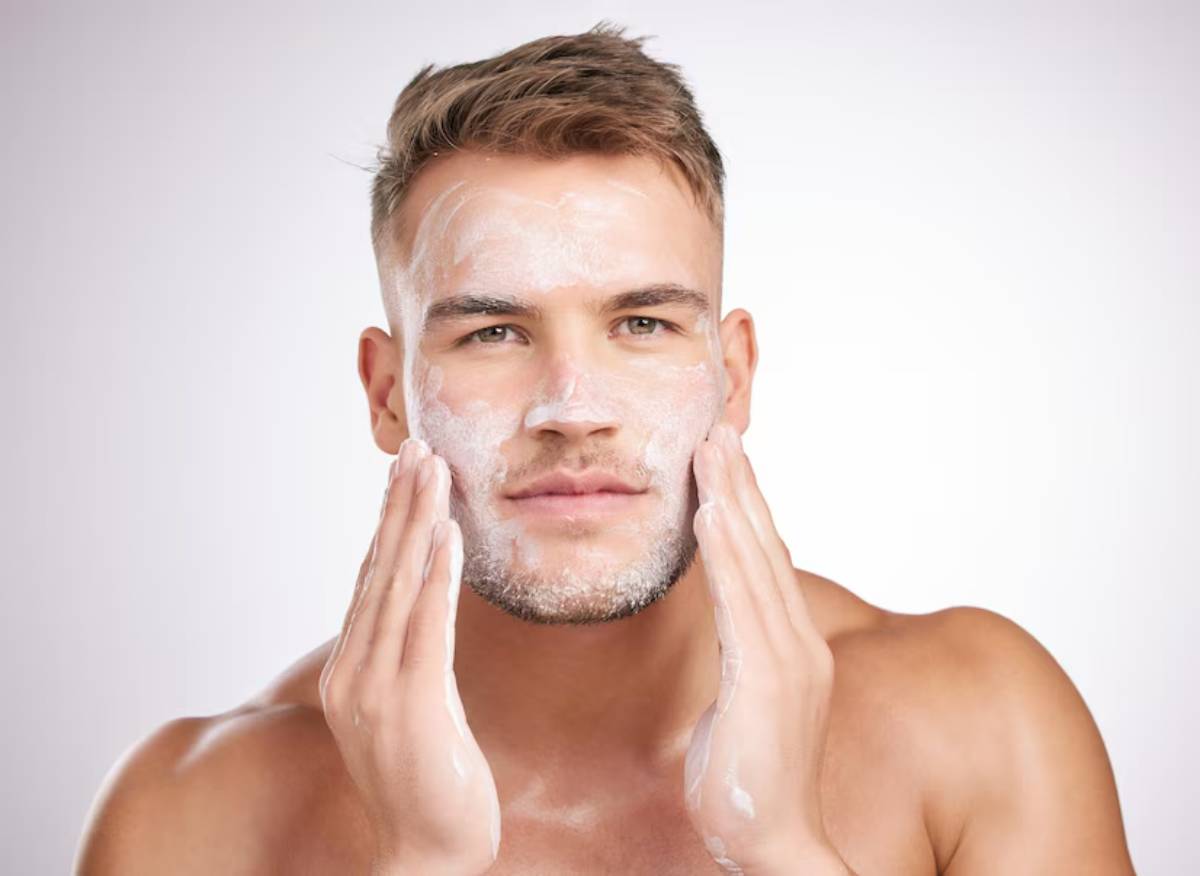
How to Identify Your Skin Type
The first rule of great skincare? Know your skin. You can’t choose the right products or build an effective routine until you understand what your skin actually needs.
Our team found that many men use the wrong skincare products simply because they’ve never identified their true skin type. This can lead to breakouts, dryness, irritation—or just wasted time and money.
This guide breaks down how to determine your skin type, recognise its traits, and use that knowledge to personalise your skincare routine. Whether you’re a skincare beginner or looking to refine your approach, this is where it all starts.
Pro Tip: Skin type isn’t fixed for life. Your environment, age, and routine can all cause changes—so it pays to reassess every now and then.
Quick Guide: The Five Main Skin Types for Men
- Normal – Balanced, even texture, few issues
- Oily – Shiny appearance, prone to breakouts
- Dry – Tight, flaky, or rough texture
- Combination – Oily in some areas (T-zone), dry in others
- Sensitive – Reacts easily to products, weather, or shaving
Important: Your skin type affects how your skin behaves and how it reacts to products. Understanding it is key to solving skin concerns and choosing the right ingredients.
Step 1: Perform the Bare-Face Test
This simple test helps you assess your skin type without needing any products or tools.

What to Do:
- Wash your face with a gentle cleanser
- Pat dry—don’t apply any products
- Wait 30–60 minutes
- Check your skin in the mirror and feel its texture
What to Look For:
- Shiny all over → Oily
- Tight or flaky → Dry
- Shiny T-zone, dry elsewhere → Combination
- Feels soft and comfortable → Normal
- Red, itchy, or stingy → Sensitive
Pro Tip: Use blotting paper to test oil levels in different zones of your face (forehead, nose, cheeks, chin).
Step 2: Understand the Characteristics of Each Skin Type
1. Normal Skin
Balanced hydration, even tone, minimal sensitivity or breakouts.
Traits:
- Smooth texture
- No excessive oil or dry spots
- Barely noticeable pores
- Doesn’t react easily to products
Routine Focus: Maintenance. Use gentle, non-stripping products with light hydration.
2. Oily Skin
Excess oil production, enlarged pores, and a shiny look—especially by midday.
Traits:
- Shiny forehead, nose, and chin
- Frequent blackheads or acne
- Visible pores
- Makeup (if used) slides off easily
Routine Focus: Oil control without over-drying. Use foaming cleansers, oil-free moisturisers, and exfoliants like salicylic acid.

3. Dry Skin
Lacks moisture and can feel rough, tight, or itchy—especially after washing.
Traits:
- Flaking or patchiness
- Dull or rough appearance
- Feels tight after cleansing
- May sting when applying products
Routine Focus: Deep hydration and barrier repair. Use creamy cleansers and moisturisers with hyaluronic acid, ceramides, or glycerin.
4. Combination Skin
Oily in the T-zone (forehead, nose, chin) but dry or normal on the cheeks.
Traits:
- Two different skin behaviours in one face
- Breakouts in oily zones, flakiness elsewhere
- Large pores in T-zone, smaller on cheeks
Routine Focus: Balance. Use lightweight moisturisers and spot-targeting products. Don’t treat all areas the same.
5. Sensitive Skin
Easily irritated by products, weather changes, or shaving.
Traits:
- Redness, itching, or stinging
- Reactions to fragrances or alcohol-based products
- Prone to razor burn or bumps
- Feels uncomfortable with temperature extremes
Routine Focus: Soothing and protection. Use fragrance-free, alcohol-free formulas with calming ingredients like aloe vera or centella asiatica.
Step 3: Consider Other Factors That Influence Skin
Skin type is your baseline, but it’s not the whole picture. Your skin also changes based on:
Age
- Younger skin tends to be oilier
- Older skin may become drier and thinner
Season
- Cold, dry air = more dryness
- Heat and humidity = increased oil and breakouts

Lifestyle
- Poor sleep, stress, and dehydration show on your skin
- Diet and alcohol affect oil production and sensitivity
Skincare habits
- Over-cleansing or harsh exfoliants can cause dryness and irritation
- Using too many active ingredients (like acids or retinoids) can disrupt balance
Tip: Reassess your skin seasonally and after major lifestyle changes.
Step 4: Match Your Skin Type to Products That Work
Now that you know your skin type, it’s time to build a routine that supports it.
| Skin Type | Cleanser | Moisturiser | Extras |
| Normal | Gentle gel or foam | Lightweight lotion | SPF 30+ |
| Oily | Foaming or salicylic acid cleanser | Oil-free gel moisturiser | BHA exfoliant, clay mask |
| Dry | Cream cleanser | Rich cream or balm | Hyaluronic acid, overnight mask |
| Combination | Balancing gel cleanser | Gel cream moisturiser | Spot treatments for oily areas |
| Sensitive | Fragrance-free cream cleanser | Soothing lotion | Aloe vera gel, niacinamide |
Key: Treat your skin’s needs, not just trends. If a product causes stinging or redness, it’s not the right fit.
Step 5: Adjust As Your Skin Evolves
Your skin can change due to age, environment, or even the products you’re using. Watch for signs that your routine needs updating.
Signs You Need to Re-Evaluate:
- New breakouts or irritation
- Unusual dryness or tightness
- Products stop working
- Increased redness or discomfort
Try swapping one product at a time and give your skin at least 2–4 weeks to adjust before making more changes.
Common Skin Type Myths (And the Truth)
| Myth | Reality |
| “Men don’t need skincare.” | Everyone benefits from healthy skin—especially with shaving, pollution, and sun exposure. |
| “Oily skin doesn’t need moisturiser.” | Oily skin still needs hydration. Skipping it can make oiliness worse. |
| “Dry skin just needs to drink more water.” | External moisturisers are essential—hydration from the inside helps, but isn’t enough. |
| “Sensitive skin is weak.” | It’s simply reactive and needs more gentle care—not less. |
Frequently Asked Questions
1. Can I have more than one skin type?
Yes. Combination skin is very common, especially in men. You might have an oily T-zone and dry cheeks.
2. How often should I test my skin type?
Check every 3–6 months, or when you notice major changes—especially during season shifts or after introducing new products.
3. What if my skin changes after starting a new routine?
Some adjustment is normal, but if irritation or breakouts persist after 2 weeks, stop and re-evaluate your product choices.
4. Does shaving affect skin type?
Shaving can increase sensitivity and dryness, especially if done frequently or with harsh products. Use gentle aftershave balms and moisturisers to protect your skin barrier.
5. Can I rely on online quizzes to tell my skin type?
They can help guide you—but the bare-face test and observing your skin over time are more reliable.
Know Your Skin, Care With Confidence
The foundation of every good skincare routine is knowing your skin type. By identifying whether you’re oily, dry, normal, combination, or sensitive, you gain the clarity needed to choose products that work for you—not against you.
Once you understand what your skin is telling you, everything else—cleansers, moisturisers, treatments—becomes easier, more effective, and more enjoyable. Because skincare isn’t just about how you look. It’s about how you feel in your skin, every day.


